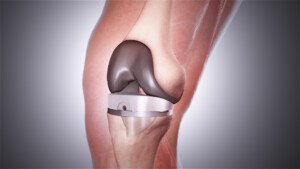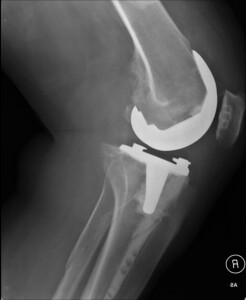You had your knee replacement surgery eight weeks ago yet the knee is still pretty swollen and hurts. How normal – or abnormal – is this?
“I would find it unusual if the knee was NOT swollen eight weeks out, and, in fact, most knees stay swollen for months,” says Barbara Bergin, MD, board certified orthopedic surgeon at and co-founder of Texas Orthopedics, Sports & Rehabilitation Associates.
“Many patients note that the knee does not achieve a state of normalcy for nine months to a year!
“The knee is a very superficial joint. You can see its shape between the femur and the tibia, where you cannot see the shape of your hip because it is buried deep within the muscles of the thigh.
“The knee does not have much collateral circulation, and it simply takes a long time for the post-operative edema to dissipate.
“The venous and lymphatic channels have to be re-established following the trauma of the surgery.
“This is a slow process. The hip has more soft tissue and collateral circulation around it, and it is higher up in the body, closer to the large blood vessels which drain the lower extremities.
The skin around a knee is tight, where it is not as tight around the hip.”
Cause of Knee Pain and Swelling Eight Weeks Out from Replacement Surgery

Scientific Animations, CC/BY-SA/Attribution-ShareAlike 4.0 International
Dr. Bergin explains, “The surgeon has cut the ends of the bones off with a saw, completely dislocated the kneecap, cut out all the cartilages between the two bones, and then spread the filleted soft tissues apart with vigor, in order to expose the knee for the operation.
“Then we pound in a metal prosthesis on top of burning cement, which is used to glue the metal in place.
“Then immediately following the surgery, the patient must move the painful site immediately, and every day after that until they achieve full range of motion, or risk developing a permanent contracture.”
Get Moving!
The surgeon will want the patient up and moving as soon as possible after surgery once the general anesthesia has worn off.
No time is wasted with this process. The hospital wing where knee replacement patients are recovering has hallways always busy with patients being walked up and down by nurses and aides.
This is one type of surgery where rest is NOT encouraged after the procedure.
Immediate and frequent movement is encouraged also to prevent the formation of blood clots in the legs.
“Every morning, after sleeping all night with the knee in most likely a flexed position, the range of motion must be re-established by forcing the knee and re-breaking the adhesions which want to develop during the night,” explains Dr. Bergin.
Solutions to Knee Pain and Swelling from Joint Replacement Surgery
Once the patient understands the mechanical reasons (e.g., sawing the bone) for why pain and swelling continue to linger eight weeks after the operation, that individual will psychologically be better able to tolerate the pain and the visibility of the edema.
They will no longer fear that “something went wrong” or that the surgeon “left something in there.”
Quite frankly, the knee pain following a joint replacement can be brutal. Some patients have described it as “the worst pain to have.”
(Of course, people with agonizing back pain or migraines or who’ve given birth would vehemently beg to differ.)
“Additionally, every patient is different with regard to their tolerance for pain,” says Dr. Bergin.
“While one patient might take pain pills for about a week after their surgery, another patient might need them for longer.
“Each physician must make a decision with regard to their patient’s experience of pain, based on their knowledge of that patient.”



























